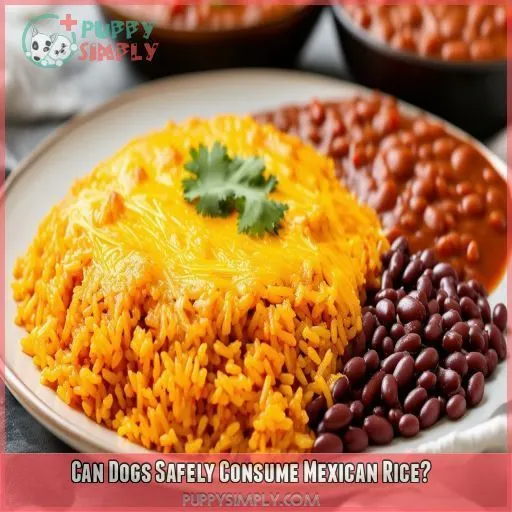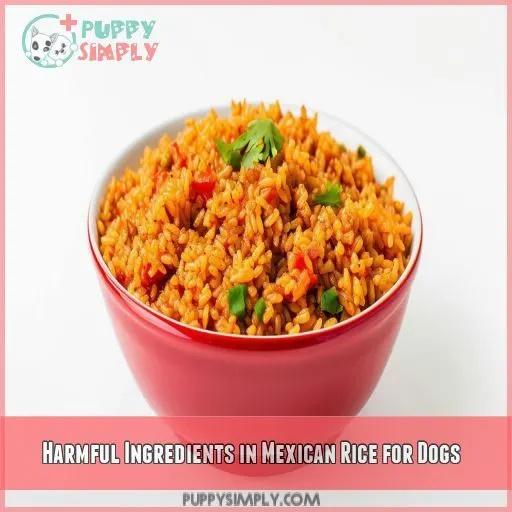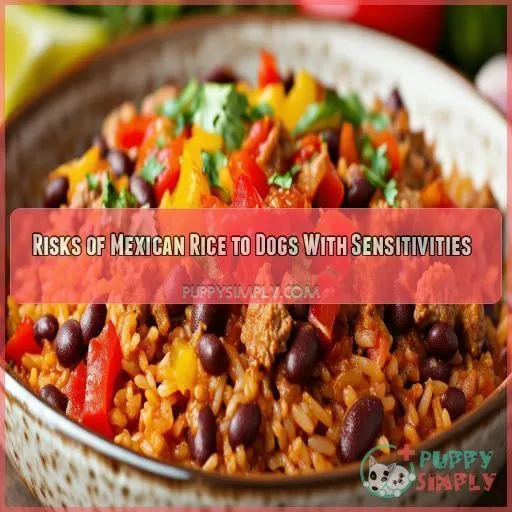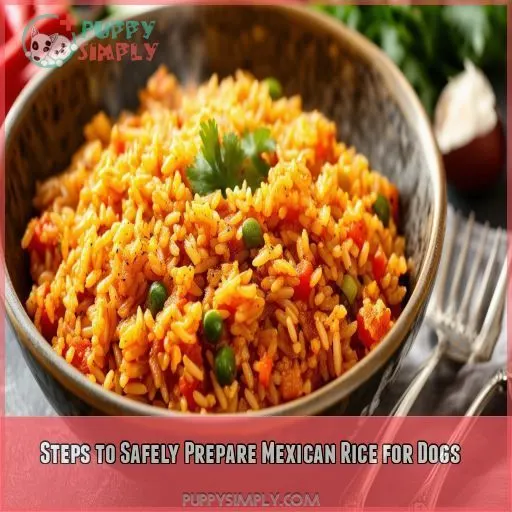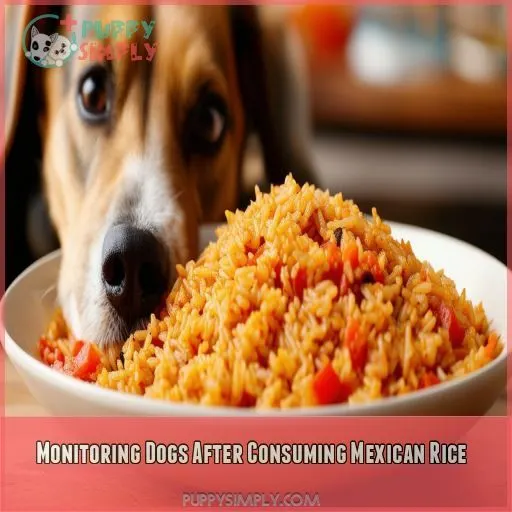This site is supported by our readers. We may earn a commission, at no cost to you, if you purchase through links.

Onions, garlic, and chili powder in Mexican rice dishes are toxic for dogs and can irritate their tummies.
Go for plain white rice, rinsed well to remove excess starch. Toast it without oils or seasonings, then simmer in water or low-sodium broth.
A little tomato puree is okay, but spices and rich sauces may trigger gastrointestinal upset in sensitive pups.
Monitor closely after they eat Mexican rice, and discontinue if any concerning signs arise.
With some care, this treat offers extra energy.
But for the full scoop, keep reading!
Table Of Contents
- Key Takeaways
- Can Dogs Eat Mexican Rice?
- Can Dogs Safely Consume Mexican Rice?
- Harmful Ingredients in Mexican Rice for Dogs
- Risks of Mexican Rice to Dogs With Sensitivities
- Steps to Safely Prepare Mexican Rice for Dogs
- Monitoring Dogs After Consuming Mexican Rice
- Seeking Veterinary Advice in Cases of Digestive Distress
- Frequently Asked Questions (FAQs)
- Is Mexican food safe for dogs?
- What kind of rice can dogs not eat?
- Can dogs eat Spanish yellow rice?
- Can dogs eat arroz with pollo?
- How much Mexican rice is safe for dogs?
- Can puppies eat Mexican rice?
- Is white or brown rice better for dogs?
- Are rice alternatives like quinoa safe for dogs?
- How often can dogs have Mexican rice treats?
- Conclusion
Key Takeaways
- Kick spices like onions and garlic to the curb when whipping up Mexican rice for Fido – they’re a real tummy trouble tornado!
- Plain white rice is the holy grail here. Rinse it, toast it dry, and simmer it in some low-sodium broth for a pup-approved fiesta of flavors.
- A little Tomato puree can liven up the party, but keep it light – too much acidity could turn your furry friend’s stomach into a salsa dance studio.
- Portion control is pivotal. A scant 1/4 cup per 20 lbs of pup is the sweet spot for this occasional indulgence. Any more and you might be cleaning up a guacamole-esque mess!
Can Dogs Eat Mexican Rice?
Yes, dogs can eat plain, unseasoned Mexican rice in moderation. However, traditional Mexican rice recipes often contain ingredients like onions, garlic, and spicy seasonings that are toxic to dogs and should be avoided.
Can Dogs Safely Consume Mexican Rice?
You may be wondering if Mexican rice is safe for your furry friend.
The good news is that plain, unseasoned Mexican rice can be a nutritious addition to your dog’s diet. It provides lasting energy from complex carbs and essential nutrients like iron and B vitamins.
However, you’ll want to avoid serving Mexican rice with added ingredients like onions, garlic, or spicy seasonings, as these can cause gastrointestinal upset.
When prepared properly with just rice and a small amount of tomato puree, Mexican rice makes a tasty occasional treat for dogs without digestive issues.
Harmful Ingredients in Mexican Rice for Dogs
When preparing Mexican rice for dogs, it’s essential to avoid including onions, garlic, and other alliums, as these are toxic to canines. Chili powder is another potential hazard, as the capsaicin can irritate a dog’s gastrointestinal tract and cause discomfort.
Onions, Garlic, and Alliums
You must avoid onions, garlic, and other alliums when preparing Mexican rice for your pup. These spices are highly toxic and can cause anemia or an upset tummy in dogs, even in small amounts. For your pet’s safety, it’s imperative to omit these prohibited ingredients and seek veterinary advice if your dog ingests them.
Chili Powder
Chili powder, common in Mexican rice, contains capsaicin that may trigger digestive issues in dogs.
The spice, combined with ingredients like tomato sauce or beef stock, can lead to stomach upset.
If your dog ingested Mexican rice with chili powder, watch for signs of discomfort and contact a vet if needed.
Monitoring your pet closely after consuming foods with chili powder is important for their well-being.
Risks of Mexican Rice to Dogs With Sensitivities
While plain white rice is generally safe for dogs, you’ll want to be extra cautious if your pup has existing sensitivities or allergies.
The spices and seasonings in Mexican rice, like cumin and chili powder, could trigger gastrointestinal issues in dogs with food intolerances.
Even the tomato-based sauce could upset a sensitive stomach.
For overweight dogs, the added calories from oils and sauces in Mexican rice aren’t ideal.
And brown rice may be harder to digest than plain white rice for some pups.
If your dog has a sensitive system, it’s best to stick to unseasoned, boiled white rice.
Steps to Safely Prepare Mexican Rice for Dogs
To safely prepare Mexican rice for dogs, start by selecting plain, white medium-grain rice and thoroughly rinsing and soaking it to remove excess starch. Toast the rice in a dry pan without oils or seasonings before simmering it in water or low-sodium broth, adding just a small amount of tomato puree or sauce for flavor if desired.
Selecting Plain, White Rice
When selecting plain, white rice for your dog, consider its grain size, cooking methods, and soaking time. The quality of rice and its complex carbohydrates can support your dog’s immune system .
Proper Washing and Soaking
After selecting plain white rice, you’ll want to thoroughly rinse and soak it to remove excess starch and impurities (Source). Proper soaking guarantees the rice is easier for your pup to digest (Source).
Toasting Without Oils or Seasonings
When toasting Mexican rice for dogs, use a dry pan without oils or seasonings. Toast the rice until golden brown, ensuring a light, fluffy texture and preserved flavor without unwanted additives .
Minimal Use of Tomato Products
You’ll want to use tomato products minimally, as their acidity can upset your pup’s stomach in large amounts.
Monitoring Dogs After Consuming Mexican Rice
After feeding your pup Mexican rice prepared safely, keep a watchful eye for any adverse reactions.
Dogs with food allergies or intolerances may experience vomiting, diarrhea, or other digestive issues despite your precautions. (Source)
Closely monitor their behavior, appetite, and bowel movements over the next 24-48 hours. If you notice any concerning signs like lethargy, abdominal discomfort, or repeated vomiting, discontinue the rice immediately.
While some mild gastrointestinal upset may resolve independently, persistent symptoms warrant a call to your veterinarian for guidance on managing potential food intolerance.
Seeking Veterinary Advice in Cases of Digestive Distress
In cases of digestive distress after consuming Mexican rice, it’s essential to monitor your dog closely for any signs of intolerance, flare-ups, or other underlying health issues, especially if your dog has a history of inflammatory bowel disease.
If your dog becomes lethargic, vomits or shows signs of gastritis, consider seeking veterinary advice promptly.
While over-the-counter antacids like famotidine can help reduce stomach acid, ER visits may be necessary for a definitive diagnosis and medication prescription, particularly if there’s a possibility of intolerances, flare-ups, or cold-like viruses causing discomfort.
In these situations, professional veterinary care is essential for the well-being of your pet.
Frequently Asked Questions (FAQs)
Is Mexican food safe for dogs?
You’ll want to be cautious with Mexican food and dogs. Many ingredients like onions, garlic, and spices can upset their stomachs. Stick to plain rice for a safer option.
What kind of rice can dogs not eat?
You’ll want to avoid rice varieties with added seasonings, oils, or sauces – these can upset your dog’s stomach. Stick to plain, cooked white or brown rice that’s unsalted and free of any additional ingredients.
Can dogs eat Spanish yellow rice?
Let’s steer clear of Spanish yellow rice, amigo. While a dash of spice may tantalize your taste buds, those vibrant seasonings could wreak havoc on Fido’s sensitive stomach. Plain white rice is a safer, pup-approved option.
Can dogs eat arroz with pollo?
You should avoid giving your dog arroz con pollo. The chicken broth, spices, and onions can upset your dog’s stomach and even be toxic. Stick to plain, boiled white rice as an occasional treat for your furry friend.
How much Mexican rice is safe for dogs?
Experts recommend no more than 1/4 cup of plain, unseasoned Mexican rice per 20 lbs of body weight for occasional treats. Too much can cause gastrointestinal issues for dogs.
Can puppies eat Mexican rice?
Puppies’ digestive systems are delicate, so it’s best to avoid Mexican rice. The seasonings and tomatoes can cause stomach upset. Stick to plain, boiled white rice for young dogs until their system matures.
Is white or brown rice better for dogs?
White rice is better; it’s highly digestible and easier on dogs’ stomachs. Brown rice contains more fiber, nutrients, but can cause gas and loose stools if fed in excess.
Are rice alternatives like quinoa safe for dogs?
Yes, quinoa is generally safe for dogs in moderation. It’s a nutritious grain rich in protein, fiber, and antioxidants. However, introduce it slowly to avoid digestive upset.
How often can dogs have Mexican rice treats?
You can offer Mexican rice occasionally as a treat. Rice should make up no more than 10% of their diet to avoid gastrointestinal issues. Plain, unseasoned rice is best.
Conclusion
While feeding your pup Mexican rice requires traversing a perilous path of possible dangers, thoughtful preparation enables this treat to become an occasional, energy-boosting indulgence.
By carefully removing toxic ingredients like onions, garlic, and chili powder, and adhering to plain, unseasoned white rice, you can confidently allow your furry friend to savor this delectable dish.
Just monitor closely after serving, discontinuing if any concerning signs arise.
With vigilance, can dogs eat Mexican rice becomes an enthusiastic yes for pet owners seeking variety.

